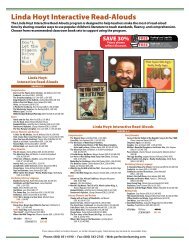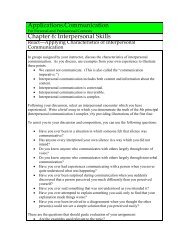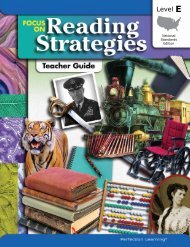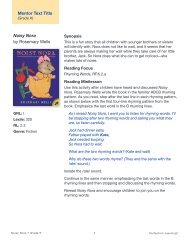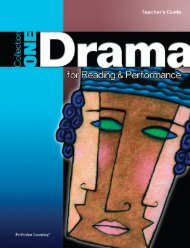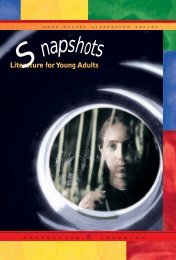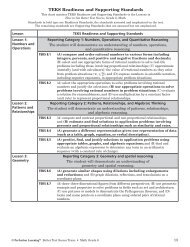Creative Communication - Perfection Learning
Creative Communication - Perfection Learning
Creative Communication - Perfection Learning
You also want an ePaper? Increase the reach of your titles
YUMPU automatically turns print PDFs into web optimized ePapers that Google loves.
Unit 1: <strong>Creative</strong> Theatre<br />
4<br />
The exercises, games, and improvisations in this drama section will help you achieve<br />
the above two qualities of total awareness and response, developing a creative and<br />
communicative You. The assignments will mainly be improvisations where you make up<br />
action and words on the spur-of-the-moment in order to achieve the game’s goal. As in<br />
any game, there are certain ground rules that the participants—you, your classmates,<br />
and your teacher—must accept. Here they are:<br />
(1) Work toward the focal point. In each improvisation you will have a specific focal<br />
point or goal on which to concentrate, allowing you to be successful at one thing at a<br />
time. All of your powers and energy must be directed toward that focal point. Your<br />
whole being should be absorbed by it. In so doing, you will solve the problem or achieve<br />
the goal.<br />
(2) Do anything you wish within the focal point and the rules. Complete freedom is<br />
yours as long as you stay within these rules and the specific goal of your activity. Don’t<br />
worry about “making a fool” of yourself. Anything goes. There is no right or wrong way<br />
to solve the acting problem. What you must strive for is an effective way—and there<br />
may be many of those. So you will want to respect what your classmates are doing, even<br />
if it is different from what you are doing. In turn, they will respect your activity.<br />
Remember, everyone has his or her own special way. Do your own thing; do not copy<br />
others. If what you are doing works well within the rules, continue. If not, change it.<br />
(3) Believe what you are doing—and do it in a believable way. Even if you are seeing<br />
imaginary things, believe them. Work toward truth in every situation.<br />
(4) Create a spirit of working together. Most of the improvisations must be done as a<br />
group, working in harmony. You are not competing with each other, but contributing in<br />
a stimulating way to the solution of the problem. Even the audience is part of the<br />
experience, for you must share with them if communication is to take place. Accept your<br />
responsibility as a valuable group member. If you make wisecracks or clown or manipulate<br />
others, you are hindering, not helping the group. Remember, these activities are not “kid<br />
stuff.” These same games and improvisations are used in professional acting courses.<br />
(5) Respond to side coaching. Your teacher will serve as a guide or director, sometimes<br />
being part of the acting group and sometimes being part of the audience. When seeing<br />
your needs or those of the scene, your teacher will “side coach” you with a voice command<br />
that you are to obey. When you hear side coaching, don’t stop what you are doing. Just<br />
listen to what is being said and keep on with the scene, adjusting to the command.<br />
In side coaching, your teacher is not suggesting that you are doing something good or<br />
bad, but rather is helping you to develop and communicate the specific thing you are<br />
doing. Side coaching is completely spontaneous, arising from what is going on at that<br />
moment. Examples are, “Really see the apple tree. Feel the bark, its roughness. Touch<br />
the smooth leaves. Reach high for the fruit.” “Share your voice with us.” “Feel with your<br />
knees, your toes, your whole body.” “Concentrate on your focal point.” “Talk to each<br />
other. Pursue that point.”<br />
<strong>Creative</strong> <strong>Communication</strong>—Hardcover Student Edition sampler




